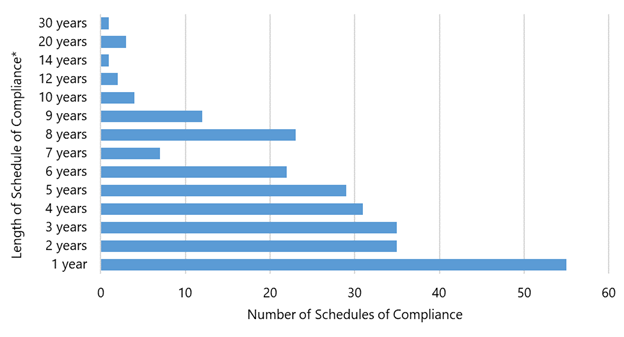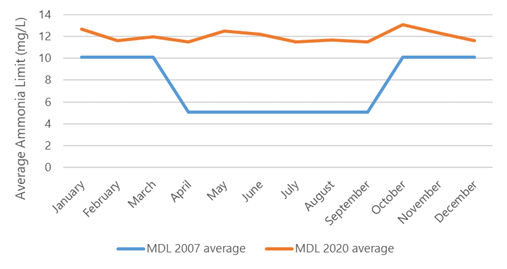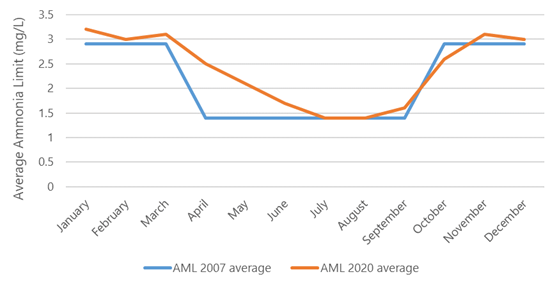Division of Environmental Quality Director: Kyra Moore
Ammonia is a common constituent in domestic wastewater and can be toxic to aquatic life. The Missouri Department of Natural Resources works with permittees to identify ammonia criteria compliance options that are both cost-effective and protective of Missouri’s waters.
Part 1: Missouri’s Ammonia Water Quality Criteria
What is ammonia and how does it enter the water?
Ammonia is one of many forms of nitrogen that occurs in the environment. Ammonia nitrogen (NH3-N) comes from the metabolic waste of humans and other animals and the decomposition of organic matter. Ammonia is also commercially produced and used for fertilizer. Ammonia enters surface waters directly through municipal and domestic discharges of wastewater and indirectly through runoff of animal waste and fertilizer from agricultural fields.
Impacts of ammonia on aquatic life
At high concentrations, ammonia in surface waters is toxic to fish, shellfish and aquatic invertebrates. Ammonia toxicity can cause and contribute to fish kill events. In addition to immediate (acute) impacts on aquatic life, such as mortality, ammonia toxicity can also cause long-term (chronic) impacts through reduced rates of reproduction, growth and survival. Ammonia also contributes to nutrient pollution (eutrophication) of surface waters. Eutrophication can deplete dissolved oxygen levels and lead to low dissolved oxygen conditions (hypoxia), fish kills and changes to food web structure that can impact entire aquatic ecosystems.
Requirements to address ammonia under the Clean Water Act
The U.S. Environmental Protection Agency (EPA) develops and makes recommendations for water quality criteria under Section 304(a) of the federal Clean Water Act. EPA recommends criteria based on pollutant toxicity data, research and scientific judgments on the relationship between pollutant concentrations and environmental effects. States use Section 304(a) criteria as guidance when adopting their water quality standards (WQS). States must adopt water quality criteria recommended by EPA to protect designated uses (e.g., aquatic life protection) or adopt, where appropriate, other scientifically defensible water quality criteria that are as protective as the EPA criteria. Because ammonia is toxic to aquatic organisms, it is a regulated pollutant under federal and state clean water laws. EPA delegates Missouri as the authority to adopt ammonia criteria into its WQS and control discharges or releases of the pollutant through permitting programs.
Missouri’s ammonia WQS
In 2000, EPA cited Missouri with failure to adopt their 1999 Update of Ambient Water Quality Criteria for Ammonia and threatened to promulgate the criteria for Missouri, pursuant to the Clean Water Act. The 1999 update contained EPA’s most recent freshwater aquatic life criteria for ammonia at the time, which were developed to protect both cold water species (e.g., trout), as well as early life stages of warm water species (e.g., bluegill). On Nov. 30, 2005, the Department adopted the 1999 ammonia criteria through rulemaking.
The Department presents Missouri’s acute and chronic ammonia criteria for the protection of aquatic life use in 10 CSR 20-7.031 Tables B1 and B2, respectively. Acute criteria apply to all waters of the state (Section 644.016, RSMo.), while chronic criteria apply to all waters in the Missouri Use Designation Dataset [10 CSR 20-7.031(1)(Q)]. Ammonia toxicity relates to several environmental factors, including pH and temperature. In general, ammonia toxicity increases with increasing pH and temperature. Maximum ammonia concentrations that protect aquatic life use are calculated based on one (acute) or both (chronic) of these factors.
Aquatic life (fish) in river systems in Northern Missouri
Fifteen unique river basins comprise the river networks north of the Missouri River. Data collected by the Resource Assessment and Monitoring Program (RAM) of the Missouri Department of Conservation demonstrate these systems support a diverse assemblage of fish species that range in habitat use from big rivers to small streams. From 1994–2019, RAM collected more than 790 fish community samples and identified at least 125 unique fish species in these river basins. Some common species include creek chub, green sunfish, bluegill, channel catfish, river carpsucker, and multiple species of shiners, minnows and stonerollers.
Headwater streams are important in protecting recreational and economically-important downstream fish species. They provide areas and for spawning and rearing, and supply prey and food for downstream species.
Use Attainability Analyses
A use attainability analysis (UAA) is a structured scientific assessment of the factors affecting the attainment of “fishable/swimmable” uses specified in the Clean Water Act. Permittees have sought the Department’s advice regarding the use of UAAs to establish the aquatic life protection use does not exist on certain headwater streams in Missouri. If the WQS do not designate the aquatic life use, the criteria listed in the rule to protect that use, such as ammonia, would not apply to the water body.
The Department has found UAAs to be ineffective for regulatory relief under these conditions because headwater streams support diverse and abundant aquatic communities. For example, the RAM fish community data described above have identified 93 unique fish species from headwaters (first and second order streams) north of the Missouri River. Headwater community samples have contained as many as 28 unique species and more than 2,000 fish.
Part 2: Reducing Impacts to Permittees
The federal Clean Water Act and Missouri Clean Water Law prohibit the discharge of pollutants and water contaminates by a point source into waters of the state, without a Missouri State Operating Permit (permit). A permit’s purpose is to establish terms and conditions, based on federal and state statutes and regulations that ensure the discharge does not impair the uses of the receiving waters. A common misconception is permits prohibit any and all discharge of pollutants. This is not the case; permits do allow for the discharge of pollutants, but only at levels protective of the uses. Because ammonia can be toxic to aquatic life, permits establish limits, taking into account the volume and characteristics of the discharge and receiving water.
Ammonia limits can be a challenge for municipalities with older systems that were not designed with these limits in mind. For this reason, the Department has developed the following suite of strategies and options to make compliance more feasible, reduce the financial impact and avoid costly plant upgrades whenever possible.
Funding resources for communities
The Department assists communities through its Financial Assistance Center, including the Missouri Clean Water State Revolving Fund (CWSRF). While the CWSRF is primarily a low-interest loan program, the Department provides grants, including Affordability Grants, Regionalization Incentive Grants, Water Quality Incentive Grants and Engineering Report Grants. More information is available online.
Lagoon retrofits, modifications, and conversions to wastewater irrigation
In the past, engineers generally did not design lagoons in Missouri to meet current ammonia permit limits. That does not mean, however, the existing infrastructure is outdated or no longer useful. Technological advancements in the wastewater industry allow for lagoon retrofits, which add ammonia-reducing technologies to existing systems. These retrofits are functional and come at a lesser cost than abandoning a lagoon and building a new mechanical WWTF. The cities of Linn, Puxico and Lamar have successfully modified their existing lagoon systems with retrofits in lieu of upgrading to traditional mechanical activated-sludge WWTFs.
Not all solutions require changes to infrastructure; changes in operations can sometimes achieve compliance. In a community with a decreasing population, the lagoon may be receiving less wastewater than it was designed for. Lagoon operators may have more opportunity to control discharges and maximize the treatment capacity of their lagoon. Controlling flows can provide permitting flexibilities with respect to ammonia that allow for less stringent permit requirements that still protect water quality. When the Department reviews applications and draft permits, it investigates flow data to see where these opportunities exist. The cities of Fairfax and Newton have used these flexibilities in response to operational changes at their lagoons.
Another option is to convert a discharging lagoon to a no-discharge system that uses partially treated wastewater for irrigation. This eliminates the requirement for water quality-based permit limits. The permit includes operating conditions to ensure wastewater is prevented from leaving the irrigation fields and flowing into waters of the state.
Regionalization/Consolidation
Routing wastewater flows to another WWTF can be a cost-effective compliance strategy and may even eliminate the need for a permit altogether. Several factors may limit this option: distance to the nearest collection/treatment system, the area’s topography and soil type, the receiving WWTF’s available treatment capacity and the challenge of developing connection agreements that are viable to all parties. The Department offers grants designed for facilities considering this option.
Relocation of discharge for dilution
Missouri’s WQS allows for mixing in waters where a permanent flow can dilute pollutant concentrations. The greater the dilution in the receiving stream, the higher the ammonia concentration can be at end of pipe, while still protecting aquatic life. Dilution can be particularly useful for small discharges into large streams and rivers. Permits for dischargers to large rivers, such as the Missouri and Mississippi, may not even require ammonia limits because the risk of exceeding the water quality criteria is very low. Permit writers investigate stream flow via online tools and available instream data.
In some circumstances, relocating a discharge to a larger body of water may be a more cost-effective option than upgrading a WWTF. Most lagoons were designed prior to current ammonia criteria, so instream mixing was not considered. As a result, the lagoon discharge generally goes to the first-available body of water. However, a nearby larger stream could provide adequate dilution. By simply rerouting or extending the discharge pipe from the smaller stream to larger downstream waters, a treatment facility may achieve a cost-effective mechanism to achieve compliance.
Regulatory Flexibilities
Regulatory flexibilities include schedules of compliance, affordability analyses and water quality standard variances. When needed, the Department explores ammonia compliance strategies with each permittee to find options that fit for the unique situation.
Schedules of Compliance
Many permittees are unable to comply with the new requirements immediately upon issuance of the permit. State regulations provide the ability to establish schedules of compliance, which allow a permittee adequate time to plan, finance, design and construct needed components to attain compliance. Regulations require schedules to be “as soon as possible.” For example, a lagoon may receive an eight-year schedule of compliance reflecting the need for an upgrade; whereas, a mechanical plant may receive a two-year schedule reflecting the need to simply make operational adjustments. The length of a schedule of compliance for ammonia is unique to each facility and the amount of time needed to obtain compliance. The Department began establishing ammonia requirements in permits soon after the adoption of the 2005 criteria and gave permittees a five-year permit cycle to monitor their effluent for ammonia. Following that monitoring period, permit writers began establishing schedules of compliance to meet ammonia limits. Currently, the Department permits 262 municipal WWTFs, with schedules of compliance for ammonia ranging from one to 30 years (Figure 1).

*These data may reflect continuations of schedules from previous permits. For example, a permit may contain a two-year schedule of compliance, which is the remaining portion of the original eight-year schedule.
Through the years, the Department has been able to lengthen schedules of compliance based on a variety of factors, such as changes to state regulations and statutes. Section 644.145, RSMo, requires the Department to make an affordability determination for any new requirement placed in a municipal WWTF permit. This determination examines the ability of a ratepayer within a community to afford the resulting user fee. Permit writers actively work with communities to obtain relevant financial information during the permit renewal process, as well as throughout the drafting of the permit. The resulting determination establishes a financial burden for the community, which the Department can use to justify a longer schedule of compliance that will mitigate economic impact to ratepayers.
WQS Variances
A WQS variance is a time-limited change for a specific pollutant that provides relief from meeting permit limits. The Department can write a variance for a specific discharger or multiple dischargers, and has adopted a multiple-discharger variance (MDV) for ammonia. The MDV is a variance from the statewide ammonia criteria for well-functioning municipal lagoons that cannot comply due to the social and economic impacts the upgrade costs and subsequent rate increases would have on the community. EPA approved Missouri’s MDV for ammonia in July 2019. The Department is working with several communities to complete the application process and expects to use the MDV as a compliance tool for many years.
Part 3: Revised Total Ammonia Nitrogen Criteria Implementation Guidance
As part of continuing efforts to find compliance solutions, the Department conducted an evaluation of how ammonia limits were calculated in the past. This review’s findings compelled the Department to replace its 2007 Total Ammonia Nitrogen Criteria Implementation Guidance. The new 2020 guidance removes overly conservative assumptions used in past limit calculations, which results in less stringent ammonia limits. Because this policy change is recent, only 12 municipalities have benefited so far. Figures 4 and 5 show the respective changes to ammonia maximum daily limits (MDLs) and average monthly limits (AMLs) for these 12 municipal permits.


Part 4: Communication
The Department communicates with permittees so that new requirements and means to comply are fully discussed and understood. The Department will never establish a new permit requirement, such as ammonia limits, without an offer to discuss compliance options with a permittee. Permit writers reach out to permittees during the application and drafting process, but are always available to discuss compliance options. Further, the Department holds outreach events, such as the quarterly Clean Water Forum, where we share regulatory information with the public and gather input on new policies and procedures. It is important the Department and permittees work together toward compliance solutions that are cost effective and protective of water quality.
Nothing in this document may be used to implement any enforcement action or levy any penalty unless promulgated by rule under chapter 536 or authorized by statute.
For more information
Water Protection Program
Division of Environmental Quality
P.O. Box 176
Jefferson City, MO 65102-0176
United States
